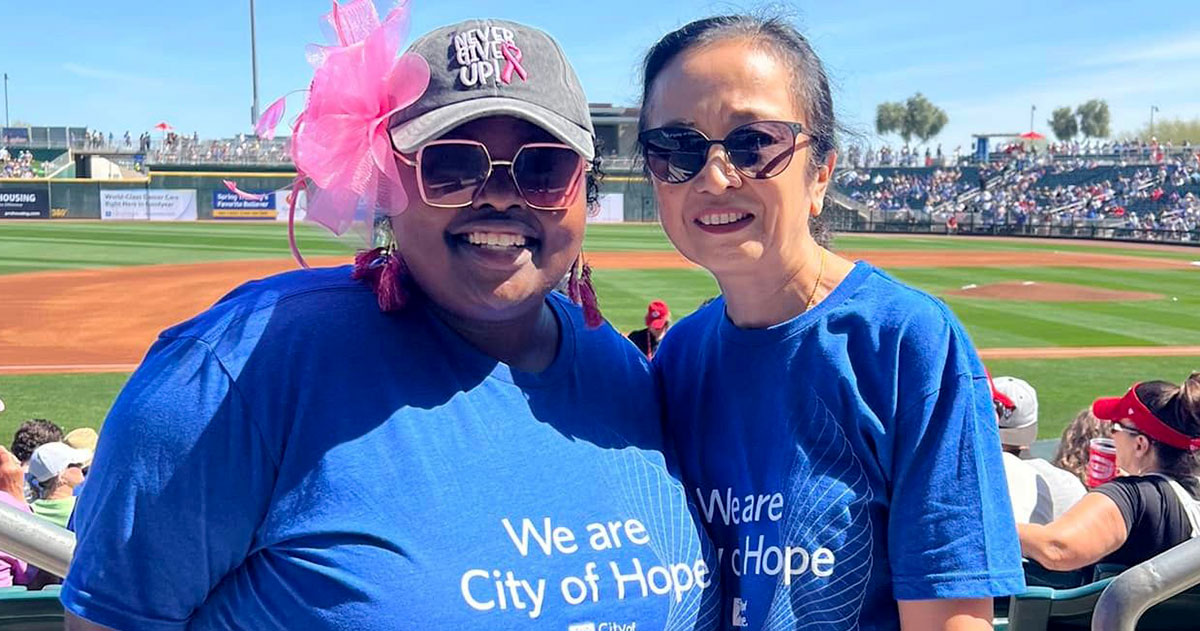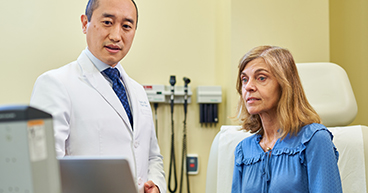
There she was—breast cancer patient Onjalai Brown running the bases before a Major League Baseball spring training game. Wearing a pink tutu and her trademark radiant smile, Brown gave players lining the baselines enthusiastic high fives as she passed them during her home run trot. When she reached home plate, Brown celebrated with arms raised, the symbolic end to a cancer journey she almost didn’t complete.
After Brown finished her Home Run for Life trot and was done waving at the cheering fans at Goodyear Ballpark in Arizona, she was reunited with Sagun Shrestha, M.D., Medical Director of Medical Oncology, City of Hope Phoenix. While Dr. Shrestha did not run the bases with Brown that day, she was at her patient’s side during much of her cancer treatment after Brown had sought a second opinion at City of Hope.
“For her to see me … in a tutu running around the bases—that let her know how well I was doing,” Brown said. “And the way she greeted me—she just said, ‘I'm so proud of you, and you look wonderful.’”
Diagnosed with invasive ductal carcinoma in 2021 after finding a lump in her breast during a self-exam, Brown was initially treated at a medical center in Texas, where her sister also underwent breast cancer treatment. While she said her sister received good care, she eventually succumbed to her disease. Brown felt she needed to look elsewhere. She eventually made the courageous decision to go beyond the familiar and past the borders of her city and state and seek a second opinion more than 1,000 miles away at City of Hope Phoenix.
“I went for a consultation and fell in love with it,” Brown said. “It was a night-and-day difference from other medical institutions. From pickup at the airport by the transportation team to the initial consultation with the physician, it was an incredible experience, and I decided to treat there, even if it meant traveling back and forth from the Dallas area.”

The value of a second opinion for cancer
You might think that after getting a diagnosis as serious as cancer, seeking a second opinion would be a no-brainer. But research shows otherwise.
A Gallup poll showed that 70 percent of Americans feel confident enough in their doctor not to seek another opinion. And while your doctors work hard to foster trusting relationships with their patients, it may also be in your best interest to seek out a second opinion that may result in new diagnoses and treatment options.
“I always encourage our patients when they come here for the first time or, even if they’re undergoing treatment, to seek a second opinion,” Dr. Shrestha said. “In terms of someone getting diagnosed, it's always a good idea to have a second opinion.”
Another study showed that, after their cases were reviewed by a multidisciplinary tumor board, 43 percent of breast cancer patients who sought a second opinion received a different diagnosis. In many cases, the staging of the cancer also changed, which often affects treatment options.
“Sometimes, when patients come in for a second opinion, we tell them they’re on the right track, and it encourages them to continue treatment,” Dr. Shrestha said. “And sometimes, we find something different, and we say, ‘OK, that's not the correct diagnosis, and we need to do something different.’”
‘She was very aggressive with my care’
Once Brown was admitted, Dr. Shrestha and her care team went to work reviewing her medical records, imaging scans, blood work and other test results in order to confirm her diagnoses and develop treatment options that best fit her needs and goals.
Because of her personal circumstances, Brown opted for a lumpectomy rather than a mastectomy. Then, a genetic test that revealed a BRCA gene mutation and results from an Oncotype DX gene expression test indicated that Brown’s breast cancer had a higher-than-normal chance of recurring.
For Dr. Shrestha, those results set in motion a standard-of-care plan designed to attack cancer cells that may have remained behind after surgery and to help reduce the chance of the cancer returning. After surgery, Brown was given four rounds of combination chemotherapy with cyclophosphamide and doxorubicin, dubbed the “Red Devil” because of its bright color and difficult side effects. That was followed by 12 more chemotherapy treatments and 30-plus rounds of radiation therapy.
After multiple hospital visits and while enduring often-difficult side effects, Brown began to question her treatment options. Her concerns were promptly addressed after a candid discussion with her doctor.
“Dr. Shrestha was being very aggressive with my care,” Brown said. “And I remember having an honest conversation about it. Her response removed every layer and barrier that I had, and I appreciated that she didn't dismiss me. She invited me to the conversation. She heard what I had to say. She empathized with me and understood how and why I would feel that way.”
Dr. Shrestha said she took Brown’s concerns to heart and made sure to take the time to address her concerns and allay her fears.
“She really appreciated how her care team here was able to walk her through what was going to happen,” Dr. Shrestha said. “And she knew why certain decisions were being made. And she really appreciated that.”
Dr. Shrestha also took into account Brown’s difficult personal circumstances. Brown suffered a miscarriage just before her diagnosis and her marriage collapsed soon after. Her frequent trips to Phoenix eventually led to her decision to resign from her job, which required her to work onsite.
Then came the chemotherapy and its difficult side effects, including depression. Brown said she sunk so low that she had contemplated suicide.
“She opened up to us that her personal life was in shambles,” Dr. Shrestha said. “We talked about it often, and I do like to talk to patients about their circumstances. That's how we catch issues that help us make better decisions about referrals to other departments and recommendations for supportive care.”
‘It’s just a great feeling’
Today, Brown is on maintenance therapy with hormone blockers—again, standard of care for her circumstances. She’s moved to Phoenix, started a new job and a new life, and tests so far have found no evidence of disease. She’s also steered her energy to help other patients through Cancer Fighters®, a program made up of volunteer survivors who help patients and caregivers navigate their cancer journeys.
Dr. Shrestha said watching Brown joyfully circle the bases at Goodyear Ballpark gave her great satisfaction. She recalled the patient who had hit the lowest of low points, who was now filled with joy and optimism. Dr. Shrestha threw out the first pitch before that ballgame between the Dodgers and the Angels. Then came their joyous reunion.
“It was really nice to see her,” Dr. Shrestha said. “She was all excited, and her friends were there to cheer her on. It's just a really great thing to see a young patient like her and the emotional connection we have. It's just a great feeling.”
If you’ve been diagnosed with cancer or and want to get a second opinion of your diagnosis or treatment options, call us or chat online with a member of our team.


